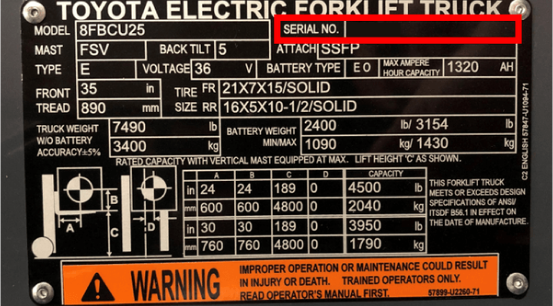How to Find Your Equipment Model Number
Finding the right parts for your equipment is easy when you have your model and serial number which can be found on the data plate. Luckily, a forklift data plate is installed on every truck on the market to help you understand what your forklift can do and provide vital information.
Model Number: The model number of your toyota forklift is extremely important for relaying information to your dealers about repair or technical assistance and for looking up replacements part!
Serial Number: The serial number on your lift is the most important number.The model serial number combination will allow us to provide you with the parts that will fit your particular piece of equipment.

How to Find Your Equipment Serial Number
Finding the right parts for your equipment is easy when you have your model and serial number which can be found on the data plate. Luckily, a forklift data plate is installed on every truck on the market to help you understand what your forklift can do and provide vital information.
Model Number: The model number of your toyota forklift is extremely important for relaying information to your dealers about repair or technical assistance and for looking up replacements part!
Serial Number: The serial number on your lift is the most important number.The model serial number combination will allow us to provide you with the parts that will fit your particular piece of equipment.

Need some help? For further assistance or more information, contact your local Toyota Dealer.

Please click below to sign in to your MyToyota account
Don't have an account?
Safe Forklift Use On Ramps And Inclines

Driving forklifts up and down slopes, inclines, and ramps is a day-to-day activity required in many facilities. The task of moving loads on these obstacles should always be approached with caution and only performed by operators who have trained to do so. To help you better understand safety concerns with ramps, it’s useful to measure the grade of the incline.
A ramp, slope, or incline is defined as an angle that exceeds 10 percent. Calculating the incline of the ramp will require knowledge of how high the ramp rises and how far it runs, as defined by the model below.

The grade of the ramp or slope is calculated by dividing the rise by the run. In the above example, the rise of 5 ft. divided by the run of 25 ft. results in a 20% grade.
Specific precautions are required when driving forklifts on ramps with grades over 10%. Loaded forklifts must be driven with the load pointed up the ramp (good standard practice is to ALWAYS drive with the load pointed up the ramp or slope). Raise levels should be limited to the minimum height necessary for ground clearance. Forklifts must be able to safely stop on the ramp or slope, according to model specifications provided by your manufacturer.
Familiarize yourself with OSHA forklift ramp and grade recommendations. Understanding these guidelines is critical for operators who are required to navigate such obstacles. Among the key recommendations from OSHA are:
- Always look in the direction of travel.
- Maintain a safe distance from the edge of the ramp to prevent tipover.
- When descending a ramp with a loaded forklift, always travel in reverse with the forks and payload pointed up the grade.
- When traveling on a ramp with an unloaded forklift, always travel with the forks pointed downgrade, regardless of whether you are ascending or descending the ramp.
If you have questions about ramps, slopes, and inclines, contact your local Toyota Forklift Dealer for more information.
For pricing, parts & more, click here to find a dealer near you.